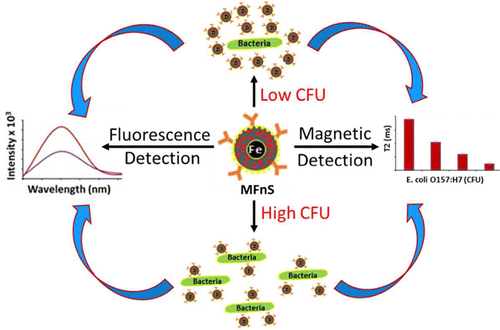Speedy bacteria detector could help prevent foodborne illnesses

It seems like almost every week another food product is being recalled because of contamination. One of the more common culprits is a pathogenic strain of E. coli. To help prevent illnesses caused by this bacteria in food or water, researchers have developed a new nanosensor to rapidly detect its presence. The study appears in the journal ACS Infectious Diseases.
Millions of illnesses and more than 1,000 deaths every year in the U.S. are attributable to foodborne illness caused by known pathogens, according to the Centers for Disease Control and Prevention. Conventional methods to screen food to find sickness-causing microbes can take as long as 24 hours, which is often too slow to efficiently catch tainted products before they hit store shelves. Faster methods exist, but have limitations. Magnetic resonance, for example, can detect extremely low levels of bacteria, but loses its effectiveness at higher bacteria concentrations. Fluorescence is the opposite. Tuhina Banerjee, Santimukul Santra and colleagues wanted to see if they could combine the two techniques to make a better detector.
The researchers developed a hybrid nanosensor incorporating magnetic resonance and fluorescence. Lab testing of milk showed the detector could sense varying concentrations of a pathogenic strain of E. coli known as O157:H7 in less than an hour. They also used their sensor to analyze E. coli levels in untreated lake water, which serves as a source of household water in some developing areas. Additionally, the device could be customized to detect a wide range of pathogens beyond E. coli, the researchers say.
More information: Tuhina Banerjee et al. Multiparametric Magneto-fluorescent Nanosensors for the Ultrasensitive Detection ofO157:H7, ACS Infectious Diseases (2016).
Abstract
Enterohemorrhagic Escherichia coli O157:H7 presents a serious threat to human health and sanitation and is a leading cause in many food- and waterborne ailments. While conventional bacterial detection methods such as PCR, fluorescent immunoassays and ELISA exhibit high sensitivity and specificity, they are relatively laborious and require sophisticated instruments. In addition, these methods often demand extensive sample preparation and have lengthy readout times. We propose a simpler and more sensitive diagnostic technique featuring multiparametric magneto-fluorescent nanosensors (MFnS). Through a combination of magnetic relaxation and fluorescence measurements, our nanosensors are able to detect bacterial contamination with concentrations as little as 1 colony-forming unit (CFU). The magnetic relaxation property of our MFnS allow for sensitive screening at low target CFU, which is complemented by fluorescence measurements of higher CFU samples. Together, these qualities allow for the detection and quantification of broad-spectrum contaminations in samples ranging from aquatic reservoirs to commercially produced food.
Provided by American Chemical Society
















